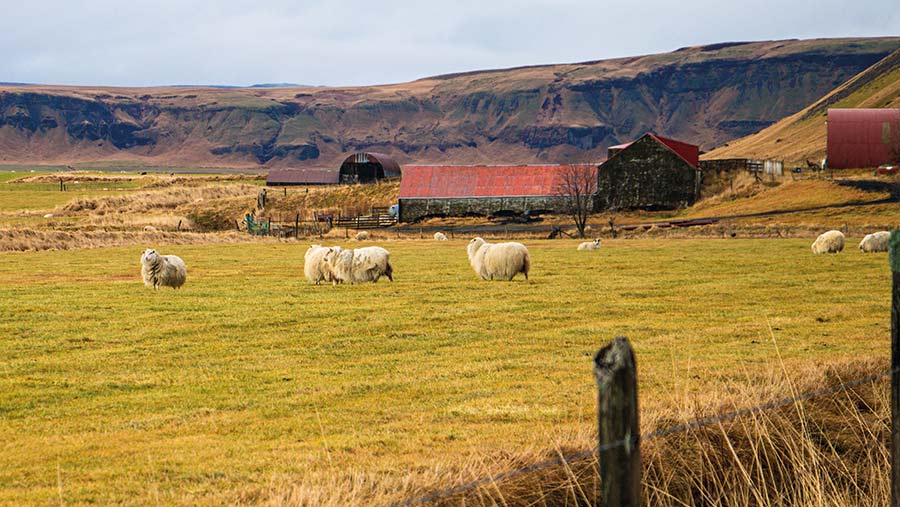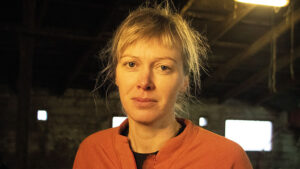How rising costs threaten future of Icelandic sheep farming
 © MAG/Rhian Price
© MAG/Rhian Price Tough and resilient – the farmers in Iceland are much like the sheep they have bred to cope with the rugged terrain and sub-Arctic winter conditions.
But many, like 44-year-old Heida Gudny, say their businesses are simply not resilient enough to cope with rising input costs.
See also: Why milking robots are a good fit for Iceland’s dairies
She has been forced to sell her 500-head sheep flock in the face of hikes in feed and fertiliser prices.
Lamb returns have stagnated at about 8,000 krona (£47 a head), since 2017, failing to keep apace with these increased costs.
“Running a sheep farm is very hard, financially. The slaughterhouse still needs its share, so primary producers are taking the hit. It is always the same,” says Ms Gudny, who has been earning her living shearing and scanning to keep her 6,464ha (15,967-acre) farm afloat.
Despite sheep quotas being in place and farmers receiving payments for lamb, grassland and arable production, Ms Gudny says she did not have a lot of quota and was reliant on good lamb returns.
“I was getting 250,000 krona a month (£1,468). It is a very unstable time. The [lamb] price has stayed the same, but costs have gone up 10%.”
It is a sombre time for Iceland – where sheep have iconic status – with numbers at an all-time low of about 380,000, down from 900,000 in 1980.
Lamb is still the island’s primary dish, but domestic consumption has fallen from nearly 13,000t in the 1980s to just over 9,000t in 2020, with poultry inching behind.
“Young people don’t know how to cook it anymore and we are having problems selling the shoulders and the ribs. Youngsters want fast food,” adds Ms Gudny.
Many sheep farmers are using government grants to diversify into tourism as the country looks to double visitor numbers to about four million over the next few years.
It is tough for farmers in Iceland to mitigate input costs, because long winters dictate that sheep must be housed for at least six months of the year.

Heida Gudny © MAG/Rhian Price
Tradition
Sheep roam on the mountains from June until September, when they will be gathered from the hill.
Icelandic farming is still steeped in tradition, with farmers joining together for the round-up, known as “rettir”.
Ms Gudny says in her region up to 20 farmers will cover thousands of miles, mainly on foot and with quad bikes, with the treacherous terrain sometimes rendering bikes too dangerous to use.
Gathering takes a week, with farmers staying in shepherd huts in the hills.
Sheep are rounded up into a wooden sheep pen shaped like a wagon wheel. Farmers catch their sheep inside an inner circle and segregate them into diagonal pens.
Families and friends travel from Reykjavik to celebrate with drinking and dancing, and feast on smoked lamb, a delicacy prepared in smokehouses built on farms.
“It is one of the highlights of the year,” says Ms Gudny.
Rettir is a physically demanding job, but the hard work is only just beginning. The long winter months signal an increase in workload.
Breeding and health
Sheep are mated at housing and will stay indoors until lambing in May when farmers work for 17 hours a day to lamb ewes and look after the newborn lambs.
Most farmers lamb over a period of four weeks and bring in family or contractors to help.
“There is no grass until June, and we can have snowstorms, even in May,” explains Ms Gudny.
The downside is that sheep can get quite fat while inside and do end up requiring assistance, adds Ms Gudny.
Special “leader” sheep still exist in many flocks. In the old days, when sheep were largely outside year-round, the leaders herded the flock to safety.
“If they refused to leave the shed in the morning there would most likely be a snowstorm coming.”
Ms Gudny admits the breed “isn’t what it used to be. The sheep are wimps in comparison [to their ancestors]. We have pampered them too much, but in the old days they knew how to survive.”
Despite this, they still have the traits required to cope with the conditions.
The fleece is dual-coated – the shorter internal layer, known as the pel, provides insulation and the longer outer layer (tog) is waterproof.
Wool is still a valued commodity, with wool from a 500-head flock typically trading for 700,000 krona (£4,122) – more than £8 a fleece.
It is mainly sold to the woollen company Istex, which processes about 99% of all Icelandic wool and is 80% farmer-owned.
Sheep are shorn twice, in November and again in March. “We remove all the wool in November and in March we leave the shorter wool on the older ones. Wool grows enormously fast after shearing,” she adds.
Shearing contractors are in short supply, so farmers largely shear sheep themselves with the help of neighbouring farmers, and the favour is returned.
Because no semen or live animals are allowed to be imported into the country, Icelandic sheep remain one of the oldest and purest breeds in the world.
Artificial insemination is widely used to bring in new bloodlines. A bonus to this breeding policy is Icelandic sheep have exceptionally high health.
“We don’t have to foot-bathe. We vaccinate for a few things before lambing and we will have to watch for watery mouth,” adds Ms Gudny.
Scrapie – an incurable, degenerative disease of the nervous system – was identified on the Island in 2020 and 2,000 sheep were culled.
But scientists have since discovered a genotype that protects animals from the disease.
DNA testing is now under way to identify rams that carry this genotype in the hope they can eradicate the disease in the next 10 years.
In the meantime, the country is split into zones and farmers can only buy animals from clean areas.
Future
For now, Ms Gudny is going to complete a degree in sociology and is hoping to offer women a place at her hill farm to rest and recuperate.
She hopes to restock once the storm of the financial crisis calms down, but admits it won’t be easy to ramp up sheep numbers with bans on live imports.
In the meantime, she and her partner, Arni Sveinungsvik, will run his 600-head sheep farm in the North.
Subsidy in Iceland
At 57% of gross income, farm support is almost twice as high as world markets, with subsidy geared towards production.
Farmers recieve about 400-600 krona/kg lamb produced (£2.30-£3.47/kg).
The numbers
1.8 lambs Number of lambs typically birthed a ewe
60-70 Number of ewes rams will mate
16-17kg Typical deadweight average of lambs
60kg Mature weight of Icelandic ewes
